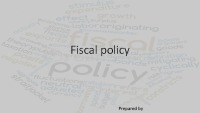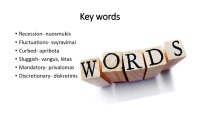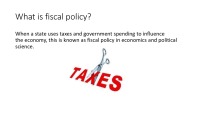Fiscal Policy



Fiscal Policy. Understanding Fiscal Policy. Fiscal Policy. Actions of Fiscal Policy. Limits of Fiscal Policy. Review. Fiscal Policy Options. Demand Side Economics. Supply Side Economics. Review. Budget Deficits and the National Debt. Deficits and National Debts. Problems with the National Debt. Review.
Recession- nuosmukis Fluctuations- svyravimai Curbed- apribota Sluggish- vangus, lėtas Mandatory- privalomas Discretionary- diskretinis.
What does fiscal policy reduces? A. TaxB. SalaryC. Schools D. Working Hours 2.What couse the fiscal policy to be implement? Complaints B.Low Economic Activity C. Boredom D.Random 3.What macroeconomics goals can not be achieved by using fiscal policy? A.Stable Prices B.Full Employment C.Economic Growth D.Economic Sutainability 4. Which type of fiscal policy is used when there is high inflation? Expansionary B. Contractionary C.Discretionary D.Pure 5.Which are indirect forms of taxation? A. Corporate Tax B. Income Tax C. Property Tax D. Goods and Services Tax.
Fiscal policy is A. the part of the economy that includes local, state, and national government. B. a force that moves an economy to the most efficient use of resources by individuals and businesses acting in their own best interest. C. carried out by a nation's central bank to manage the money supply with the objectives of promoting economic growth and stable employment without excessive inflation. D. the use of government spending and taxation policies to manage the economy. Reasons why expansionary fiscal policy is more inflationary when the economy is near the peak of a business cycle than when the economy is in a recession.
- Economy & Finance Presentations
- MS PowerPoint 327 KB
- 2018 m.
- English
- 15 pages (782 words)
- University
- Rima
















